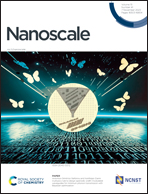On-surface synthesis and characterization of teranthene and hexanthene: ultrashort graphene nanoribbons with mixed armchair and zigzag edges†
Abstract
Graphene nanoribbons (GNRs) exhibit a broad range of physicochemical properties that critically depend on their width and edge topology. GNRs with armchair edges (AGNRs) are usually more stable than their counterparts with zigzag edges (ZGNRs) where the low-energy spin-polarized edge states render the ribbons prone to being altered by undesired chemical reactions. On the other hand, such edge-localized states make ZGNRs highly appealing for applications in spintronic and quantum technologies. For GNRs fabricated via on-surface synthesis under ultrahigh vacuum conditions on metal substrates, the expected reactivity of zigzag edges is a serious concern in view of substrate transfer and device integration under ambient conditions, but corresponding investigations are scarce. Using 10-bromo-9,9′:10′,9′′-teranthracene as a precursor, we have thus synthesized hexanthene (HA) and teranthene (TA) as model compounds for ultrashort GNRs with mixed armchair and zigzag edges, characterized their chemical and electronic structure by means of scanning probe methods, and studied their chemical reactivity upon air exposure by Raman spectroscopy. We present a detailed identification of molecular orbitals and vibrational modes, assign their origin to armchair or zigzag edges, and discuss the chemical reactivity of these edges based on characteristic Raman spectral features.



 Please wait while we load your content...
Please wait while we load your content...
